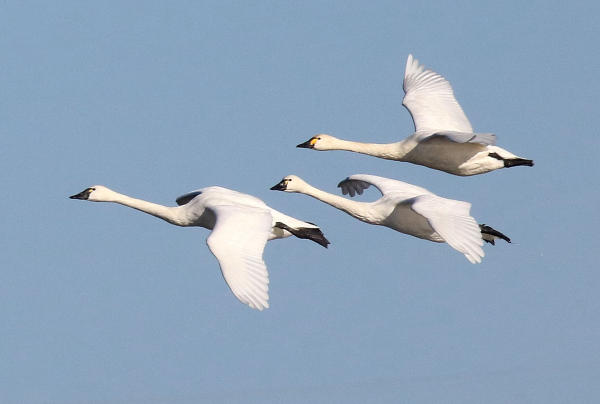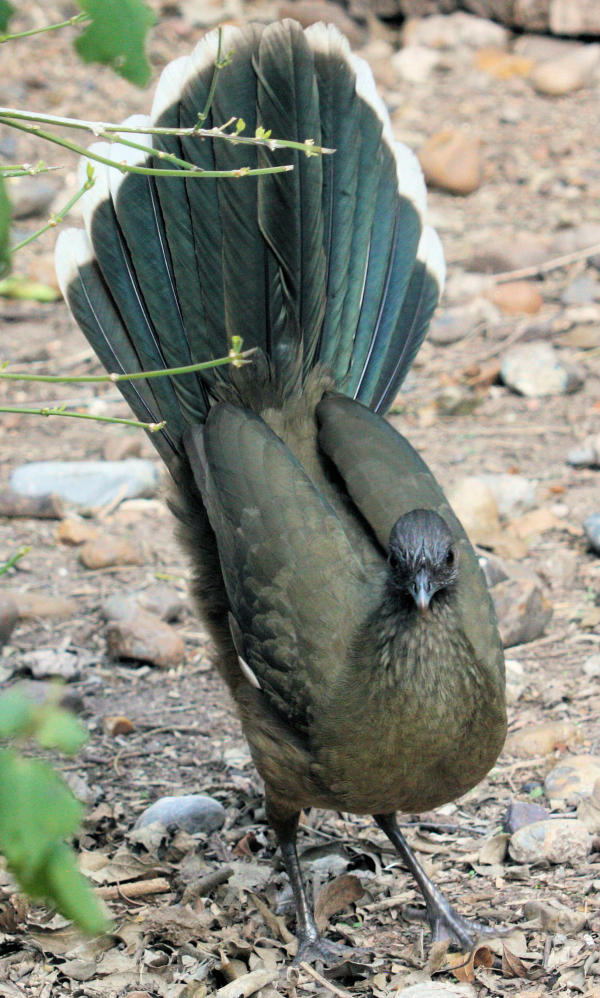
Tundra Swans are excellent representatives of the 200 species of birds that nest in the Arctic Refuge.

A Plain Chachalaca is an excellent representative of the borderland birds that make Santa Ana Refuge so important.
|
During my visit to Long Lake National Wildlife Refuge this week, a favorite “local” refuge southeast of Bismarck, I appreciated how many decades I have toured the refuge and surrounding habitats to enjoy the varied avifauna. This week I appreciated observing, and hearing, my first hundred Sandhill Cranes of the fall, among a mixed flock of Mallards and Northern Pintails. Also, scattered throughout the refuge wetlands were a few late American Avocets, hunting Northern Harriers, Great Blue Herons, Double-crested Cormorants, an immature Black-crowned Night Heron, Ring-billed Gulls, American Robins and Dark-eyed Juncos – a good selection of mid-October birds.
Here in the state that hosts the most national wildlife refuges in the nation – 63 – we take the importance of our refuge system very seriously. For the first time in decades, there is a real concern about some of the best refuges in our refuge system.
I write “our” because these refuges are absolute gems in our national wildlife refuge system, and among our American public lands that have been preserved, protected and administrated on behalf of you and I – all Americans, past, present and future – by our elected government officials and dedicated agency employees. Today, there are some refuges that face fairly dire futures, although that can be changed if you and I react and address these concerns with our government representatives.
The Arctic National Wildlife Refuge protects a huge wilderness in northeast Alaska that is referred to as America’s Serengeti, comparing Africa’s famed tropical wilderness to our Arctic wilderness refuge. But today, the Department of the Interior is moving quickly to begin development of the all-important Coastal Plain of our Arctic Refuge.
Our current members of Congress passed a measure hidden within last December’s tax bill, which passed by only two votes in the U.S. Senate, to open the Coastal Plain of our Arctic Refuge to oil and gas development.
Unless we Americans take action – millions of nesting birds will be affected, and the best example of an Arctic ecosystem and its plants and animals will be turned into a huge industrial petroleum complex operated by international oil interests. The action will destroy our Arctic National Wildlife Refuge – if we permit it to happen.
If you think you don’t have a voice in these matters, consider how birders and refuge supporters helped Santa Ana Refuge. At the other end of America from the Arctic Refuge, one of birders’ favorite South Texas destinations is our Santa Ana National Wildlife Refuge. Just a few months ago, this important refuge was slated by the current administration to be the next location to construct a border wall segment along the American side of the Rio Grande River, thereby compromising the integrity of another of our premier refuges by destroying habitat and limiting public access.
However, throngs of birders, local citizens, business people and other concerned people wrote letters to their congressional delegation, state officials and local politicians – even voicing their concerns during a protest march to save the refuge from border wall construction. Local people and people from across the country spoke up and took action – simply by writing a message or making a telephone call – and look what happens when you make your interests known. Every person who took action was part of a successful effort to let their voice be heard – and it worked! Youcan make a difference.
Congressman Vicente Gonzalez summed up that action: "For now, we've been able to save Santa Ana [Refuge] from having any kind of structure built around it, but the battle and the war's not over on this issue." Congratulations to all the individual Americans who helped in this successful endeavor – locally and nationwide! Keep up the good work!
On another scale, Eastern Neck National Wildlife Refuge, which is located so close to such American population centers as our national’s capitol city of Washington, DC; Baltimore, Maryland, and Dover, Delaware, was about to close its lands to the public – birders included. The manager position at Eastern Neck was being considered for elimination in response to reduced funding, so Friends of the refuge complex wrote to the Northeast Regional Chief in our National Wildlife Refuge System to voice their concerns, individually and collectively. There is no doubt that their efforts made the difference in the August announcement that the U.S. Fish and Wildlife Service will continue to staff Eastern Neck Refuge, and thereby continue to provide public access to our important refuge. Congratulations to all the dedicated people who helped in this endeavor!
So you see, YOU can make a big difference in protecting and promoting our national wildlife refuges. But, let’s return to the Arctic Refuge: What canwe do to continue to protect the Arctic Refuge? First, learn about the refuge at https://www.fws.gov/refuge/arctic/ although there is, surprisingly, no information about the problems currently facing our Arctic Refuge on their website pages. For the most up to date information about upcoming seismic exploration and leasing for oil and gas development in the Arctic Refuge, start with http://www.alaskawild.org/places-we-protect/arctic-refuge/
There is also an important historic human element to our Arctic Refuge related to how local Native Americans will be impacted. For more information about the Gwich’in people and their ties to the Arctic Refuge, “the scared place where life begins,” see http://ourarcticrefuge.org/
Next, email, write or call your government representatives, including your two U.S. senators, your U.S. representative, the Chief of the National Wildlife Refuge System, Cynthia Martinez, and the U.S. Secretary of the Interior, Ryan Zinke. Just a sentence or two from you can make a big difference, but communicate as much as you wish.
Foremost, be sure to vote in the upcoming election, just three weeks away!
One of the most important groups working to help on all refuge topics is the National Wildlife Refuge Association, whose bottom line on the Arctic Refuge is stated as, “We have to act now, and we have to act together, if we are to protect it. The Arctic Refuge belongs to all Americans, and this shared resource must not be irreversibly tarnished so that a select few can earn a quick profit.”
For more information about the Arctic Refuge, Santa Ana Refuge and other national wildlife refuges, see https://www.refugeassociation.org/advocacy/refuge-issues/arctic/ and for an update on Eastern Neck Refuge, see http://www.friendsofblackwater.org/help-eastern-neck.html.
Enjoy all your visits to our national wildlife refuges, during this National Wildlife Refuge Week, and any time you visit refuges. But be aware that not all refuges are safe and enduring. The future is bleak for our Arctic Refuge – unless we inform our government officials and employees that we want the current direction to change for the good of wildlife and all Americans, now and in the future. Preserve the wilderness quality of the Arctic National Wildlife Refuge.
We support the Service as they continue to focus on their mission statement: The mission of the U.S. Fish and Wildlife Service is working with others to conserve, protect and enhance fish, wildlife, plants and their habitats for the continuing benefit of the American people.
Article and photos by Paul Konrad